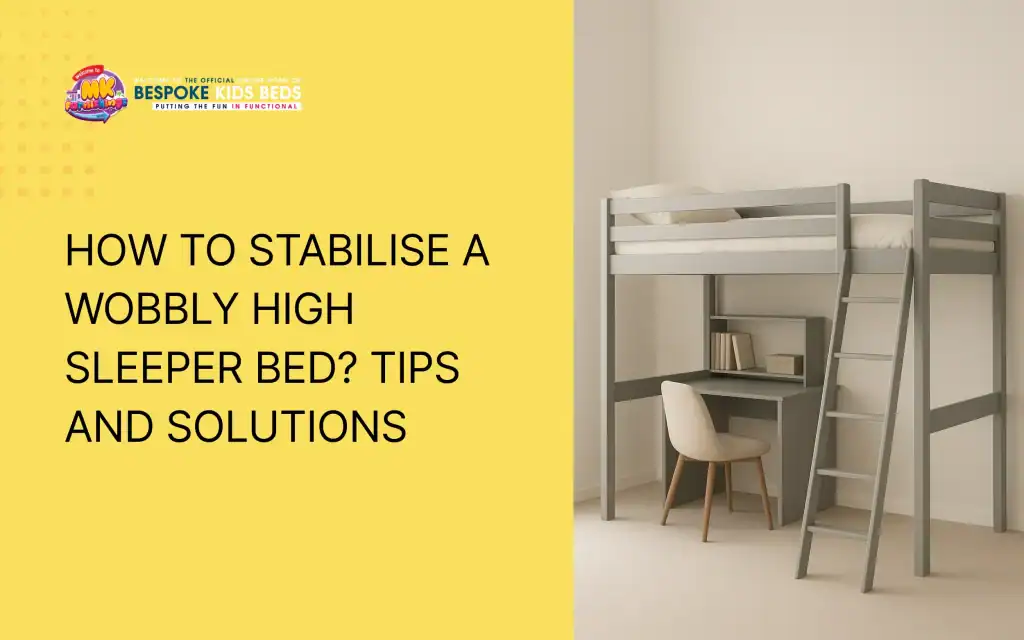
What is a Tight Top Mattress?
A tight top mattress is a mattress with a flat, even surface where the top fabric panel is tightly stitched to the side panel, creating
Enjoy FREE Delivery on All Orders!

A wobbly high sleeper bed can be stabilised by tightening all joints, reinforcing weak connections, and securing the frame to a wall for extra support. These actions restore firmness, reduce movement, and ensure safety during everyday use.
High sleeper beds are designed to save space while offering comfort and functionality, but constant use can loosen bolts or weaken joints. Applying stabilising kits, replacing flimsy parts, and checking the frame regularly helps maintain long-term stability. A properly reinforced bed not only improves safety but also extends the furniture’s lifespan, keeping it sturdy and reliable for years.
A high sleeper bed can wobble when joints loosen, frames shift, or supports weaken through frequent use or uneven flooring. This instability disrupts sleep and creates safety risks, especially for children. Identifying the cause early and applying suitable stabilising strengthen the bedframe, prevent future wobbling, and ensure stability for a long time. Reinforced joints, in particular, can reduce wobbling by up to 75%. Below are the methods to improve high sleeper bed stability:
Improving frame strength is the most effective way to reduce wobbling. A solid frame distributes weight evenly and prevents flexing under movement. Using additional support beams or corner braces helps stabilise weak sections. A reinforced frame can handle greater load without bending or creaking, extending the bed’s lifespan. You can apply reinforcement techniques using the following methods:
Metal joints often loosen over time, which causes visible shaking during use. Reinforcing these joints improves durability by about 40% and provides a firmer base for the upper frame. Applying extra screws, brackets, or welding where possible ensures a tight connection and minimises flexing. These metal joint reinforcement options are most effective:
Bed legs play a direct role in maintaining balance and vertical strength. Thin or hollow supports can bend or move under uneven weight, creating instability. Replacing them with solid wood or thick metal legs improves stability by approximately 25% and distributes the load more evenly. Consider these leg replacement improvements:
Attaching the bed to a wall provides strong lateral support and eliminates side movement. This method reduces wobbling by up to 90%, making it a preferred safety measure for children’s rooms. The connection must be firm but removable for maintenance or relocation. Follow these wall-securing methods for better results:
Most wobbling problems are caused because of loose bolts and joints. Over time, constant motion weakens fasteners, allowing small gaps that increase movement. Tightening all screws, nuts, and brackets can reduce bed movement by up to 75% and restore original stability. For effective tightening, follow these steps:
Building a strong loft bed begins with selecting the right materials and using precise assembly techniques. A well-constructed frame provides stable support, reduces movement, and ensures long-term safety. Every part, from the joints to the bolts, must be aligned to handle consistent weight and usage. Follow these key building steps for better results:
Building a sturdy loft bed depends on the strength and quality of the materials used. Both the materials and tools selected directly influence the bed’s ability to withstand weight, reduce wobbling, and maintain alignment. Essential materials and tools for building a loft bed include:
Careful material selection helps create a loft bed that remains comfortable, firm, and stable under daily use for a long time.
Constructing a loft bed involves a sequence of focused steps that determine how stable and long-lasting the final structure will be. Each stage contributes to balance, safety, and even weight distribution. By following a systematic approach, the build remains secure, preventing future instability or movement during regular use. Here are the key steps involved in building a sturdy loft bed:
Step 1: Measure and cut all beams and slats according to bed size.
Step 2: Assemble the rectangular frame using screws and corner brackets.
Step 3: Attach the vertical legs and ensure all angles are right.
Step 4: Install cross-supports under the mattress area for balanced weight.
Step 5: Fix guard rails and ladders securely to prevent movement.
Step 6: Tighten all bolts and test the structure for stability before use.
Completing each of these steps with precision results in a strong, balanced loft bed that supports significant weight and resists wobbling over time.
Selecting strong, durable materials is vital for building a loft bed that remains stable and safe over time. Here are the recommended materials for a strong and durable loft bed:
These high-quality materials provide lasting strength, reduce wobbling, and extend the bed’s life. A structure built with these elements stays comfortable, secure and dependable for regular use.
Both solid wood and metal frames provide excellent stability, but they differ in strength, appearance, and maintenance needs. Choosing between them depends on durability expectations, weight requirements, and design preferences.
Wooden frame vs. metal frame characteristics:
Each material provides lasting support when properly maintained. Solid wood excels in comfort and design warmth, while metal provides unmatched endurance and stability for daily use.
Frame design and weight capacity are key to a loft bed’s overall strength and stability. A well-built frame holds greater weight while distributing pressure evenly across all joints, reducing the strain that often causes wobbling. Reinforced connectors and precise alignment help the structure maintain shape and balance under daily use.
Key factors that influence frame design and stability:
A well-designed frame improves balance, reduces movement noise, and extends the bed’s lifespan. With strong structure and reinforced connectors, a loft bed remains firm, stable, and safe through years of consistent use.
Maintaining stability requires consistent care and prompt attention to small issues. Regular inspections prevent wear from becoming structural damage and keep the frame aligned for safe daily use. Addressing tension points, securing joints, and maintaining balance all contribute to longer bed life. Some effective preventative stability measures include:
Leveling feet and adjustable pads are practical solutions for keeping a loft bed stable on uneven or slightly sloped floors. They correct minor floor unevenness and absorb small vibrations that can cause wobbling. Adjustable pads also protect floors from scratches while helping distribute the bed’s weight more evenly. Here are the ways to install and use them effectively:
By adding leveling supports, the frame stays balanced even on slightly uneven floors. This reduces joint strain, prevents loosening, and keeps your bed steady.
Over time, screws may loosen and brackets may shift slightly due to weight and movement. To prevent such small issues from developing into structural problems, performing periodic checks is essential. Regular maintenance keeps joints tight, preserves frame alignment, and ensures the bed remains safe for long-term use. To maintain bed stability, follow these maintenance steps:
Consistent maintenance can extend a high sleeper bed’s lifespan by up to fifteen years. It also prevents wobbling, uneven weight distribution, and early wear, keeping the bed stable and reliable throughout its use.
For families searching for durable and stylish high sleeper beds, MK Furnishings stands out as one of the best furniture stores in the UK. The company specialises in high-quality, space-saving children’s furniture, including sturdy high sleeper and bunk bed designs built for safety and comfort. Each bed is crafted from premium materials and designed to provide long-lasting stability. Customers benefit from free delivery across the UK and a 24-month warranty, offering exceptional value and peace of mind.
Choosing MK Furnishings ensures reliable quality, professional service, and durable furniture tailored for modern family living. Every product is safety-tested, easy to assemble, and supported by strong customer feedback praising both build quality and design. Whether purchasing online or visiting the showroom, MK Furnishings offers trusted craftsmanship and child-friendly designs that combine practicality, comfort, and style with dependable aftercare and nationwide delivery.
To fix a wobbly loft bed, tighten all screws, bolts, and joints to eliminate looseness. Reinforce weak areas using metal brackets or corner braces, and add cross-supports for extra stability. If the floor is uneven, use leveling feet or non-slip pads to balance the structure.
Solid hardwoods such as oak, pine, or beech are ideal for strength and durability, while reinforced steel offers superior load-bearing capacity. Many high-quality loft beds combine both materials for added support and longevity.
Yes, securing the loft bed to the wall is an effective way to reduce side movement. Use stud-mounted L-brackets or heavy-duty wall anchors for strong attachment. This prevents tipping and provides added peace of mind, especially in children’s rooms.
Check and tighten all joints regularly, apply anti-slip pads, and ensure the bed sits evenly on the floor. Keeping all connections firm prevents movement and prolongs stability.
Building a sturdy loft bed requires solid materials, precise measurements, and reinforced joints. Use cross-bracing and corner brackets to support the structure and distribute weight evenly. Proper alignment during assembly makes the bed strong, safe, and wobble-free.
Kyle Kane
Owner
Kyle Kane is Co-Owner of MK Furnishings, a family-run business based in UK that specializes in high-quality custom kids’ bunk beds, including triple, double, single, and themed designs. Since launching the company in 2016 alongside his brother-in-law, Kyle has helped deliver and assemble thousands of beds across the UK, Ireland, and beyond. Focused on customer satisfaction, Kyle leads a hardworking team that handles every step from ordering to delivery ensuring a smooth and professional service. His commitment to quality craftsmanship and reliable support has earned MK Furnishings a strong reputation and growing customer base throughout the region.

A tight top mattress is a mattress with a flat, even surface where the top fabric panel is tightly stitched to the side panel, creating

Certifications like Greenguard Gold, National Bed Federation Certification, and CertiPUR US serve as verified approvals that help buyers identify mattresses that are safe and healthy
Fancy £50 off all orders! Enter in 50off to redeem in the coupon code section